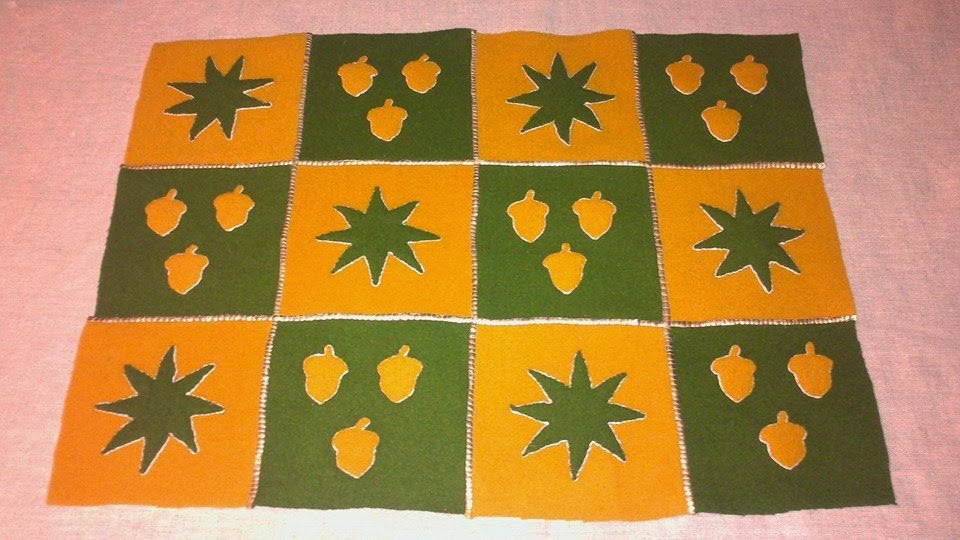I have embroidered like mad since I got home! And mostly for myself (and the family). The first project is going to be a cushion for me, with the elements of my heraldic arms (within the SCA that is), the green sun on golden background and the three golden acorns on green background. I wanted to try some appliqué and had some very nice wool at home, meant initially for a miparti-dress that never happened (the wool is a bit too heavy for a dress). First I cut all the pieces, using small paper patterns for the sun and acorns. Then I stitched all the pieces onto the ground fabric with thin linen thread and then finished it with strengthening edging in thicker linen thread in white, as can be seen in some period examples. When all the patches were done, they were pressed with a hot iron with a damp cloth inbetween, and they shaped beautifully.
Then it was assembly time, I sew the patches together with overcast stitches, small ones, they were folded out and pressed again and then on to the next patches. This was also done with the thin linen thread. And it was a very neat little project to bring with me while traveling, so my fellow train passengers looked a little puzzled for a while. No one dared ask me what I was making though, sadly. I have been getting into really interesting discussions with other travelers on other occasions, both on the long ferry rides to the mainland and on boring trainrides across the mainland.
As all the patches were assembled I started cutting thin strips of the gilded leather in order to cover the seams. And since the leather is rather stretchy you do not need to cut it in straight lines, you can follow the natural curve of the hide and it will still shape nicely when stitched down.
The leather strips were sewn down with a rather tight overcast stitch with linen thread covering the seams. Now I just need to cut some backing and make it all into that soft and pretty little cushion to
sit on. I am pondering either a nice leather so it will stand some wear, or a nice wool.
Done with that I moved on to try something completely different, the freehand blackwork (or in this case dark green...). Immensly inspired by a post by a very talented member in the Historic Hand Embroidery group I decided to stitch a little owl for the eldest son. He asks for a sewing kit of his own for his upcoming eight birthday and I wanted to make a pincushion. He loves owls, specifically Harry Potter´s owl, so the motif came naturally. This is made in stemstitch in silk on linen and I drew the little critter free hand.


For the back I took some leftover green wool from my heraldic project and stitched it together and then I covered the seams with some reversed chain stitch in bright yellow silk. I hope he will like it!
And this technique was so much fun that I decided to fulfill my promise to the youngest son and make him a linen bag for his water bottle, so that I will allow him to bring it to events. One has to give them something to keep it all fun and interesting. And for this project I even tried my centereyed embroidery needles and it works beautifully! More updates to come when this is all done.













